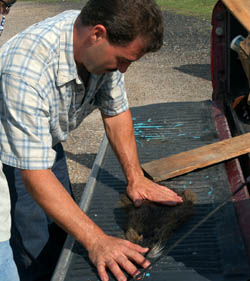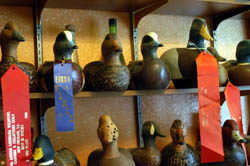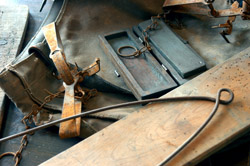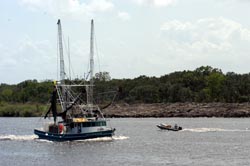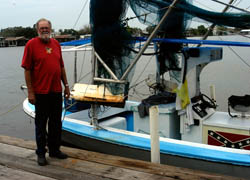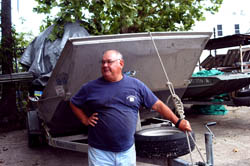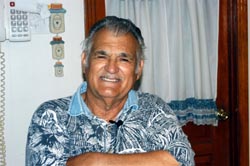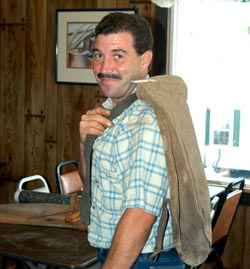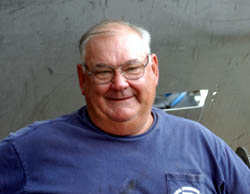Trappers of the Barataria: Nutria Traditions
By Jon and Jocelyn Donlon
Traditional Trapping
Traditional trapping of fur-bearing animals in Southeast Louisiana has not changed much over the last 100 years. The close-knit community of the Barataria region descends from Isleños, French, and German heritage. Jerry Alfonzo, of Isleño heritage, is an experienced trapper with over fifty years of experience. He speaks of making his own stretchers (small frames for stretching pelts), of skillfully skinning the animals, and of traditional methods of laying traps in water-all knowledge he inherited from his father, who learned from his father. His traps are notched, a method used by owners to identify their traps.
Mr. Alfonzo's discussion of trapping traditions is similar to that of Chris Areas (AH-ree-ahs), a young shrimper/trapper in Lafitte who is continuing the heritage thanks to the state's Nutria Control Program. Chris learned how to trap from his grandfather (though he could've learned from Jerry Alfonzo, who is his uncle). Chris speaks knowledgeably of living off the land and water of St. Bernard Parish. To begin his trapping, he bought traps from older trappers in the region, who had stored them in barrels of water (to avoid rusting) for over 40 years. He uses his father's carrying sack, stretchers, and boards. He has his beliefs about what makes for the best haul-that trapping is better than shooting because "shooting drives the creatures away." Because of the dip in the shrimping industry, Chris is learning to trap to survive, much as the older settlers did. Fuzzy Hertz, a retired pelt trader, said that his father learned how to trap to survive: "The rest of the people was doing it, so he got right in with 'em. Everybody's so friendly that a stranger would come in and they'd help him out, learning the trade." The same language applies to the younger Chris.
Trapping customs depend heavily on the material culture associated with them. Jerry Alfonzo talked of his collection of traps, from the "Gibb trap" that was discontinued fifty years ago because it is a double-spring trap, to the "V.G. trap," his personal favorite. This trap is made by Victor and is a "single spring" trap. He also uses names such as "jump trap," because it jumps when it snaps to "catch the animal further up the leg." Mr. Alfonzo is very adept at demonstrating the uses of these traps, carefully compressing the springs to set each jaw of the trap. He also owns a "rat wringer," which scrapes the excess meat off the pelt after skinning.
He and Chris Areas own a large collection of older traps, as well as handmade stretchers and boards. Chris also owns the trappers' bag used by his father. Many of these items have been handed down from generation to generation. It is also typical for the trappers to have a collection of their favorite pelts. Fuzzy Hertz has a pelt, tanned years ago at the cost of $30, that he keeps because its blonde streak rendered it defective.
Traditional Uses of Nutria: Foodways
Most of the trappers interviewed for this project report that they don't eat much nutria meat. As Douglas Robinson said, "If it tastes like chicken, why not eat chicken?!" On the other hand, Fuzzy Hertz, who has owned Fuzzy's Bar in Lafitte for more than fifty years, waxed enthusiastic about nutria meat. Even those who had never tried it had heard reports of it "tasting good." Fuzzy's family started eating the meat long after they began trapping because "the meat was so pretty." They cook it in a variety of ways: stewed, fried, barbequed, smothered, and even in spaghetti. More than for human consumption, nutria meat is often sold for animal feed.
Lore and Language of the Trappers
The legend that E.A. McIlhenny is the primary source of Louisiana's nutria problem, either because he intentionally let loose the ones he had been raising on Avery Island, or because the nutria escaped during a hurricane, is so pervasive that is has been widely cited (even in news reports). Shane Bernard, historian and curator for McIlhenny Company, has spent a great deal of time tracking down the truth behind the legend. According to his research, McIlhenny wasn't the first to have imported nutria to Louisiana; he was the third. Moreover, he never imported nutria from Argentina, as is alleged, but bought his first ones from a seller in St. Bernard Parish. McIlhenny intentionally released nutria into the wild because he wanted to establish a nutria-trapping industry. Bernard did discover that a hurricane once allowed some of McIlhenny's fur-bearing stock to escape, but nutria were not recorded among the escapees.
In addition to this legend, nutria-trapping occupational lore includes a colorful variety of stories and expressions. There is the specialized language of the material culture: the "rat wringer" that scrapes meat from the skin, or the names of traps, from "Gibb," to "jump" to "diamond" trap. There is also insider language of the region. Chris Areas, for example, talks of Lafitte folks having to move "out front" (to the city of New Orleans) to make a living. And he also talks about how his father made a living at "bustering crabs," which is the process of farming soft-shelled crabs. In the process of selling nutria, some are "sold round," as Douglas Robinson says, which means that they are sold whole. Jerry Alfonzo contributed a local expression and belief: "when the muskrat patches its nest, we know it's going to rain." And Shane Bernard told of how E.A. McIlhenny was nicknamed "M'sieu Ned," and how young nutria are called "kits." Finally, Fuzzy Hertz contributed a family saying: His father called the process of buying and selling nutria pelts a "'skin game.' The trapper would catch the animal, skin it, and the buyer would skin him, and the next buyer would skin him, and they'd get skint all the way down the line."
As historian and curator of McIlhenny Company's historical documents, Shane K. Bernard (son of musician Rod Bernard) oversees the archiving of material owned by the company, much of which has been found in a number of warehouses and in attics of abandoned houses on Avery Island. Some family members and company employees have also donated or sold items. He is a "one-man operation," and takes particular pleasure in what he calls "myth-busting."
Before he began working for McIlhenny in the mid-1990s he, like many others, had heard the nutria legend associated with Avery Island. He has seen the legend mentioned in National Geographic, The Washington Post, and Audubon. Shane stumbled across a "nutria" folder in the McIlhenny papers, and became curious to confirm or refute the story.
The legend is as follows, in Shane's words:
E. A. McIlhenny, the man who ran the Tabasco Sauce business, as a side venture began to raise nutria on Avery Island. And he imported a number of nutria from Argentina, where they're indigenous, and brought them to Louisiana and raised them in a pen somewhere on the Island. A hurricane came along in the late 1930s, early 1940s, knocked down the pen, the nutria got out, and populated the coastal salt marshes of Louisiana. It was all his fault.
The legend has variants: sometimes he introduced nutria to Louisiana; other times he introduced them to North America. Sometimes the nutria escaped during a hurricane; other times M'sieu Ned let them out on purpose-for malicious purposes.
The story researched by Shane Bernard is much more complex than the popular version. He found that E. A. McIlhenny was at least the third-rather than the first-nutria farmer in Louisiana; he was at least the second nutria farmer to set loose his nutria in the wild, on purpose. He never imported nutria from Argentina. He bought nutria from one of the two pre-existing nutria farms in Louisiana, the one in St. Bernard Parish. What's more, the detail of the hurricane is irrelevant. In fact, McIlhenny purposely released twenty-one nutria into the marsh on June 1, 1940, two months prior to the 1940 hurricane that struck in early August of that year. He did not release all of his nutria until 1945.
According to Bernard's article "Reconsidering the Origin of Nutria," published in Louisiana History in 2002 (Vol 53. No. 3, pgs. 281-293), McIlhenny purchased his first nutria in March of 1938-fourteen adults and six kits-all but two of which were born in the United States. The papers do not name the farm owner in St. Bernard Parish, but they do verify that A. Bernstein of New Orleans, a fur dealer, served as middleman in the transaction. He wrote to McIlhenny, "I am able to purchase the nutria for you for the sum of $100.00 and now you will kindly let me know what day you can send your truck to pick them up, as I must let the party know, in order that he may have them ready for shipment" (287-88).
McIlhenny posted a check to Bernstein for $100.00 on March 12, 1938, and he dispatched a landscape architect, Jim Kennedy, who was employed at Jungle Gardens, to collect the nutria. Kennedy's documented report and expenses verify the transaction. He also brought advice from Bernstein about maintaining the nutria, advising McIlhenny to "feed them carrots, beets, cabbage, grass, alfalfa, or anything green'" (Bernard 288).
Whatever difficulty McIlhenny faced with the troublesome fur-bearers was not entirely a surprise. In 1930, Armand P. Daspit, director of the Louisiana Department of Conservation's Fur and Wildlife Division, was warned in a letter from the Bureau of Biological Survey in Washington, DC (and Daspit sent a copy of the letter to McIlhenny) that "It may be highly objectionable to turn [nutria] loose. . . . Numerous examples exist in this and foreign countries of the introduction of species from one part of the world to another with very disastrous results" (Bernard 286).
McIlhenny waited eight years from the date of that letter to buy his first nutria. In the meantime, two other nutria farms began to operate in Louisiana. One was owned by Susan and Conrad Brote in St. Tammany Parish; the other was the unnamed farm in St. Bernard Parish, from which McIlhenny purchased his first nutria in 1938.
Once McIlhenny had in his possession five hundred animals, he began to sell live adults to other farmers as breeding stock. He continued to sell breed stock, until he "let all of [his] nutrias go in the marshes" in late 1945. His original aim had been "to establish a fur industry on nutria in the waste marshes of Louisiana" and he believed that he had "succeeded in doing this" (Bernard 291).
McIlhenny seems to have contributed to stories of his exaggerated role in the spread of nutria throughout the marshes. According to Bernard, "He often embellished stories, particularly about himself, in the jovial manner of a seasoned raconteur" (Bernard 284). In fact, he did claim to have been the one to introduce nutria to Louisiana, saying in a 1945 letter that later appeared in the Times-Picayune:
I originally brought fifteen pairs of the animals from the Argentine . . . [and] have liberated probably one hundred and fifty pairs of these animals in Iberia Parish since 1940, and they have spread to the northern limits of Louisiana and the extreme western limits, and have crossed over Vermilion Bay to Marsh Island (Bernard 284).
McIlhenny suffered a debilitating stroke in 1946, and passed away in August 1949. He died known to many as the one who introduced nutria to Louisiana, a legend that he, himself, cultivated. Bernard's research, however, indicates that the introduction of this now troublesome critter was much more complex.
Shane Bernard has published two books: Swamp Pop (1996) and The Cajuns (2003), both of which were published by the University of Mississippi Press. An authority on Cajun and Creole History, Bernard published an article on the subject of nutria that was picked up by the Associated Press, and appeared in over 100 newspapers. His understanding of local history is invaluable to discussions of the industry.
The Importance of Nutria to Louisiana
When nutria were first brought to Louisiana, the original intent was to sell all parts of the fertile animal. The fur is very high quality while still relatively economical, the meat is said to be tasty, and the residue had potential use in pet or livestock food. And for nearly 100 years, the plan worked. In the 1960s, 70s, and even the 1980s, over a million nutria were caught and sold, according to Jeff Marx of Louisiana Wildlife and Fisheries. However, during the 2001-2002 trapping season, the state sold fewer than 1,000 trapping licenses.(http://www.nutria.com/site4.php)
But several factors have contrived to dash this vision, and the businessmen lost interest and animals: namely, the decrease in fur wearing, the lack of interest in nutria meat as a human food, and the overabundance of nutria because of their high reproduction rate. Now, the economic impact of the nutria is chiefly a negative one, with too many of them disturbing the waterways, contributing to erosion of the coasts, and, in arable areas, meddling with the water-control structures necessary for agriculture. From the air, the broad, vegetation-free paths they create are clearly visible. Perhaps urged on by population density, the rodents do travel from fairly wild areas into cultivated fields, doing great damage to dikes, ditches, and irrigation works there as well as destroying portions of crop. The tendency to consume roots is an especially destructive trait, because doing so immediately kills the entire plant.
Ecological and Economical Impact
When the hoped-for market failed to develop, would-be fur ranchers began releasing the animals into the American wilds. The overpopulation has resulted in nutria consuming much of the available vegetation in the marshes, causing great damage to coastal parishes, primarily Terrebonne Parish. In coastal areas the effect has been to accelerate coastal erosion, especially if salt-water intrusion has acted to weaken storm-savaged vegetation.
In the trapping season spanning November 2002-March 2003, Louisiana instituted a Nutria Control Program to regulate nutria numbers rather than attempt to eradicate them. Doug Robinson, an Environmental Consultant with Coastal Environments of Baton Rouge (which had the contract to manage the program), made his way into the field every week to collect nutria tails from local trappers and to record the number and location of caught nutria. The program set up six stations along the coastline, in public places easily accessible to trappers. Before they could qualify, each trapper had to officially register with the program, obtain a valid trapping license, and provide documentation that they were trapping with the landowner's permission. Trappers were allowed to turn in tails no less than eight inches long, to discourage the trapping of baby nutria. Trappers could use traditional traps, or kill the nutria with steel pellets only. Hunters were not allowed to use lead in shotguns so that other wildlife-particularly the Bald Eagle-that feed on the dead nutria would not be poisoned. Each trapper also had to follow specific guidelines for disposing of the carcasses. Once the hunter/trapper qualified, he was paid $4.00 per tail. The hunt averaged about 20,000 nutria per week, and some hunters took home an income of $60,000 for four months of work. According to Doug Robinson, most of the captured nutria came from the area starting at the mouth of the Atchafalaya River eastward to Cocodrie.
The Nutria Control Program is targeted to last five years, with the goal of collecting at least 400,000 tails per year. Officials are even talking about the program lasting for 25 years. Some trappers sell only the tails; others skin the nutria to sell its meat and fur. One trapper made an extra $7000 by selling fur. Not surprisingly, the market for nutria meat is still quite small, though growing. Between seasons, the Department of Wildlife and Fisheries is documenting the impact of the trapping program, as well as areas of excessive damage done by the critters.
Trappers throughout South Louisiana are once again turning to the natural environment in part to support a traditional way of life. Many trappers learned the techniques from fathers and grandfathers, but for a long time have not found a viable market. Now, with the Nutria Control Program, trappers can earn a decent, traditional living while helping to save the Louisiana marshlands.
Conclusion
The research and fieldwork on nutria in the Barataria Region revealed a rich history of waterway traditions. These traditions, so recently threatened by a failing economy for trappers, has been revived by Louisiana's Nutria Control Program. While the program remains vulnerable to charges made by animal rights activists, in particular for the trappers' use of leg-hold traps, it, nevertheless, has helped locals to remain active in family and cultural traditions.
Any demonstration of these traditions will, necessarily, involve some difficult questions about the use of traps, the disposal of many pelts, and the overall uncomfortable quality of trapping. No death to the destructive and fertile animals will be pleasant to contemplate. However, it can always be stressed that nutria trapping may be the only "politically correct" form of trapping practiced today. The creatures are, in the end, contributing to the destruction of the Louisiana coastline, and a dramatic reduction in their numbers is necessary for the coast's survival. Moreover, the program provides a supplementary income for fisherfolk, whose shrimping businesses have been hard hit by the importation of foreign shrimp and low market prices.
Public programs, including narrative stages and demonstrations, can provide an effective means for educating the general public about family and cultural traditions, and the relationship of these traditions to the Barataria region's economy and ecology.
Trapper Stories
Jerry Alfonzo: Retired trapper and hunter, commercial fisherman, duck carver
In his Chalmette home in St. Bernard Parish, Jerry Alfonzo keeps an extensive collection of traps, pelts, and duck carvings. Mr. Alfonzo, of Isleños heritage, began trapping in St. Bernard Parish when he was nine years old, learning from his father, who learned from his father. He stopped trapping about ten years ago. During his fifty-plus years of trapping, he caught nearly every fur-bearing animal in Louisiana, including otter, nutria, mink, beaver, and muskrat.
Mr. Alfonzo has participated in every aspect of trapping, including catching, skinning, drying, and selling pelts. During his time, the skins were "sent to New York, and from there, they were sent to Germany and Russia." Today, Mr. Alfonzo is sometimes invited to participate in folklife festivals. When demonstrating the process of trapping, Mr. Alfonzo also shows the hand-made wooden stretchers that are used to extend the skins. These skins are turned inside out and placed in the sun for drying.
Again dismissing the complexity of his work, he repeats his claim that "there's nothing to it" when talking about the process of trapping. "The animal shows you how to trap. You put the trap where the animal passes at. You try to put it in water." If not placed in water, the trap will rust and become "hard to snap." In addition, "You set it real light; anything it touches, it snaps."
Mr. Alfonzo owns a variety of traps. The "Gibb trap," which was discontinued fifty years ago, is also called "the two-trigger trap" because of its two sets of teeth. One trap, which catches the animal by the neck, is baited. An "oyster trap," or "jump trap," will jump when it snaps in order to "catch the animal further up on the leg." A "diamond trap" has two jaws, one on the outside and one on the inside. His favorite trap is the "single spring Victor," also called "V.G." trap. This trap is made by Victor and bears a trademark "V." It pushes the animal "away from the trap so that he can't eat his leg." He shows how many traps are notched so that owners can identify theirs. He also owns a bag which carries the traps and the caught animals.
The veteran trapper displays not only knowledge of trapping traditions, but also an understanding of the animals themselves. "Otters are playful animals. They love to play. And they're very, very smart, you know," says Mr. Alfonzo. What's more, "A mink is hard to catch; you gotta really know what you're doing." Obviously, he prefers the larger pelts. "They bring more money."
Mr. Alfonso has expertise in hunting both nutria and alligator. He observes that the increased harvesting of alligator has led to greater numbers of nutria, since alligators eat a lot of nutria.
Christopher Areas: Nutria trapper, fisherman, trawler
After traveling around the United States in his youth, Chris Areas has returned to Lafitte (Jefferson Parish), now participating in family traditions of trapping, fishing, and trawling. A third-generation trapper, Chris learned the swamps from his grandfather, who was his babysitter when he was growing up in Caernarvon, St. Bernard Parish. As a child, Chris also worked on his uncle's shrimp boat. Chris's father worked at "bustering" crabs, which is the process of molting crabs to produce soft-shells. Chris recollects being taught to negotiate the marsh as a youngster, and he speaks proudly of teaching his two boys in turn.
Chris identifies strongly with his Isleños heritage, though he didn't learn Spanish in school. (He says that adults wanted to be able to talk about things in Spanish without the children understanding.) "The Isleños all come from the Canary Islands, you know, and when I was young my grandma took me to visit, to see the Canary Island relatives. We got there, and my grandma asked to be taken to see some relatives. They took us to the graveyard. 'There they all are,' they said. 'No, live ones!' my grandma said. They told us, 'This is it; they here or in America! They died or they went over there.'"
Growing up, Chris's life followed the seasons, living at a camp for part of the year, then trawling, then home. Both his grandfathers had trapping camps in St. Bernard Parish. Original land grants gave families, including the Areas family, a piece of land "from the river to the lake, so you had trap land in the winter, high land to grow your vegetables. That's why we had to learn different aspects of work." Indeed, Chris has a notion that "you have to learn everything."
In 2002, Chris participated in Louisiana's Nutria Control Program. He believes the program saved him from bankruptcy. After difficult years on the boat, he trapped on 686 acres of family land in St. Bernard Parish, living at the camp in order to deter poachers. He turned in approximately 400-500 tails per week, at $4.00 tail. To get started, he bought traps from older people on the bayou, who trapped 40 years ago and had traps in storage. He began with 36 traps and gradually added to his stock. He decided on traps rather than shooting because, first, it was less expensive, and, second, he didn't want to "spook" the animals into the bushes. He was also trying to sell the meat and pelts to local dealer Leo Kerner, and trapping better preserves them. He sold meat for $.75, the body for $1.00.
Because of coastal erosion, the circumstances at the family camp are very different now from what they were when Chris was growing up. Where there used to be enough land to play football, there is now water. Nevertheless, Chris has deep reservations about the choices being made to address erosion. Also, he has been publicly involved in debate over the decline of the shrimping industry. The market is depressed for many products, from fur to shrimp. At the time of the interview, shrimpers were getting $.55/lb, down from $1.10 in 2001. He says that his boat can't "hold enough shrimp to pay for the fuel and groceries to go out." Thus, many people are going "out front," (which means moving to the city of New Orleans from Lafitte) for income. Chris has serious concerns about the future of the local seafood markets.
Edward "Fuzzy" Hertz: Nutria Dealer
Fifty-odd years ago, Edward "Fuzzy" Hertz opened "Fuzzy's Bar" in Lafitte, which he still runs today and where we interviewed him. Fuzzy Hertz was born and raised in the Gretna/Lafitte area of Jefferson Parish. While he says that his mother was "real real" French," his father, who was a fur trapper and pelt dealer in Lafitte, was of German heritage. Fuzzy says that his father learned how to trap "to survive. . . . The rest of the people was doing it, so he got right in with 'em. Everybody's so friendly that a stranger would come in and they'd help him out, learning the trade."
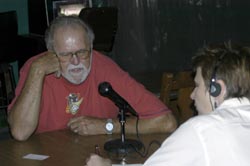
Fuzzy Hertz was born and raised in the Gretna/Lafitte area. Until 1999, Fuzzy worked for over fifty years as a pelt dealer, taking over his father's business. He bought nutrias, among other fur-bearing animals, and then he skinned, cleaned, dried, and resold the pelts to brokers, who would ship them overseas for processing. Fuzzy believes that no American market exists because "it would cost so much money to process" nutria pelts, which are larger than many other pelts. Tanning the pelts is also expensive. "Years ago," Fuzzy says, "I had one tanned, and it cost me $30 for that one." This pelt was considered defective because it had a blonde streak through it.
Today, most brokers that bought Fuzzy's pelts have died, and the "young people didn't want to take over," unlike Fuzzy, who took over his dad's dealing business. Typically, Fuzzy sold pelts to the Steinberg Brothers and Mayer Brothers of New Orleans. "My Daddy was always telling me it's a `skin game.' The trapper would catch the animal, skin it, and the buyer would skin him, and the next buyer would skin him, and he'd get skint all the way down the line."
Louisiana's trapping season starts in October, after "first cold spell, and after fishing," and it ends in March. Fuzzy's busiest years were during the 1970s. One year, they bought 46,000 pelts at $.25 pelt. "By the time we sold the meat we was doing a nickel or dime on the nutria." The industry, according to Fuzzy, started slowing down in the early 80s, declined every year. Fuzzy doesn't blame animal rights groups; rather, he blames "poverty.people didn't want to buy fur." His business closed in 1999 when his shed burned, with 75 beavers in the drying room. He hadn't actually bought any pelts that year; Leo Kerner, another local fur dealer, was shipping pelts to Fuzzy, who was working them for him.
When the Hertz family first started buying nutria, they dealt only with the meat, which they bought at .03/lb. Fuzzy says that, fifty years ago, "nobody saved skins." He credits Woody Dufresne, of Norco, for "starting people saving fur and trying to get sales for em."
When dealing in nutria meat, Fuzzy says, "We would skin 'em, wash the fur, dry 'em, and then turn 'em inside out-put the meat on the outside-on these little boards, we call 'em boards, like a mold. We'd dry the meat. We had drying rooms up in the big shed, and then we'd take 'em off these boards, and put 'em in sacks and then go sell 'em to different ones. [The meat] was dry, and stinky, too. Real smelly."
The meat was sold primarily to alligator and mink farms. "Different people would come and they would buy thousands of pounds at a time. We had a trailer truck used to come from Wisconsin for [food for] the minks. We'd take the skin off [of the nutria], gut it, take all the intestines out, put it in a cooler, ice it up real good, and the trailer-truck would come like twice a week, take thousands and thousands of pounds of meat and go all the way to Wisconsin. They had the mink farms."
The Hertz family worked with nutria long before they began to eat the meat. They started eating it, however, because "the meat was so pretty; it's prettier than chicken.real, real nice. Very potent." They cooked the meat in a variety of ways: stewed, fried, barbequed, smothered with onions, and even in spaghetti. Mr. Hertz is a living example of cultural traditions in the Lafitte region. He no longer deals in nutria pelts, but can speak about them, as well as about the fishing traditions. He owns a shrimp boat, and continues to make hauls.
Douglas Robinson: Project Manager, Louisiana Nutria Control Program
Douglas Robinson, a native of Baton Rouge, has used his business administration degree from Southeastern (1967) while dealing with the paperwork involved with the Louisiana Nutria Control Program. Doug, an Environmental Consultant with Coastal Environments of Baton Rouge (which handled a contract to carry out the particulars of the Nutria Control Program) does much of the fieldwork, and virtually all the special building for the firm. During our interview, he pointed out a yards- long bulletin board and building adaptations he'd done, as he took us to the gear barn. There, he pointed out his various modifications and special-use adaptations made to the airboats.
Mr. Robinson has been with Coastal Environments for more than five years. A native of South Louisiana, Robinson was once a commercial fisherman, so he was experienced in the outdoors before coming aboard. He has worked on such projects as monitoring seismograph, construction, maintenance, and Christmas Tree projects (using Christmas trees to trap sediment and build up barriers against coastal erosion) around the state. Recently he moved 8,000 trees to a pond in St. Charles Parish to act as a settlement barrier and deter erosion there.
Currently, Mr. Robinson is supervisor of Louisiana's Nutria Control Program. When the bottom fell out of the fur market, there was little or no active incentive to trap. The introduction of the Nutria Control Program, instituted to stymie ongoing environmental impact and damage, paid a fee for helping to reduce the overall size of the wild population. As Robinson explains, the awareness of nutria damage is so acute, that some large landowners demand that the trappers using their acreage also cull a certain quota of nutria in order to maintain their alligator license.
While nutria are not solely responsible for damage to Louisiana's coastline, they play a significant role. "Nutria," Doug says, "are vegetarians. And they love the roots. So, once the start eating the roots, the plant dies. Once the plant dies, any wave action, any of that, will start eroding. They'll start in a good healthy marsh. They will start, start in the middle, and before you know it, it's just a sinkhole, just open. No vegetation." The process continues, he explains, since the wave action doesn't allow new plants to take root.
"You have to remember, Robinson said, "eight to ten years ago there were approximately a thousand trappers going out. These thousand trappers were taking about a million nutria a year out. This went on for about four years. Then the price of fur made a total drop, from the overseas market. And, I think, last year, I'm going to say 200-250 trappers took 25 to 40,000. That was it. There was no demand. They couldn't make money off it," he explained.
Alligators eat nutria as food, but not enough of them. A large nutria weighs 15-18 lbs, and "it takes a big alligator to eat something like that," says Robinson. Alligators also feed off of muskrat, fish, birds, and other wildlife, so their appetite, alone, is not enough to control the damage done by the water rat. What's more, nutria can breed roughly three times a year, and can start breeding when they're thirty days old, and produce a litter of five-six. "They're walking baby makers," according to Doug.
To control the damage to the coastline, the federal and state governments have established Louisiana's Nutria Control Program, regulated by the Department of Wildlife and Fisheries. The program is funded for five years, at least. Coastal Environment won the contract to monitor tail collection and locations of harvesting. C.E. set up monitoring stations along the coastline. Rockefeller Refuge, Cameron Parish, and Abbeville were not as active as Morgan City, Houma, Luling, and Chalmette. The four active sites were visited each week. Ultimately, Terrebonne and Plaquemines Parishes saw the most activity.
For the program, a special 16-foot trailer was constructed, complete with refrigeration for the collected tails. The Coastal Environments team would travel just about daily to one or another collection point. Their goal was to build morale and enthusiasm among the trappers who participated, so they also made very sure the paperwork was done to record the catches and to generate the return checks.
The program began on November 20 with 250 participants, and ended on March 31 with 500. According to Jeff Marx, at Wildlife and Fisheries, 308,160 nutria were caught during the four months. Each trapper was required to maintain a valid trapping license, to gain the state's permission to hunt/trap public land, and to obtain the landowner's permission to work private land.
Participants were restricted to approved sites, to daylight hours, to harvesting only adult nutria, and to either trapping or to shooting with steel bullets (to avoid lead pollution). Whether participants hunted or trapped was determined by cost (shooting is much cheaper), vegetation (in some marshy areas, only trapping was feasible), the tide (a big tidal movement can put traps underwater), and whether or not the body would be sold for fur and meat (which necessitates trapping to avoid damage or lead poisoning).
Once the nutria was killed, the hunter/trapper had to cut the tail, sink the bodies in the marsh or bury them. The trapper was issued a registered card so that his/her collected tails could be documented for payment at $4.00 per tail. Coastal Environments disposed of the tails at an approved BRI landfill in Sorrento. Some participants kept the bodies to sell for meat and fur, though the demand is not high. They could sell meat for $1.00, and the fur for $2-3. A lot of animals were sold "round"-sold whole. The buyer would then skin them, and process the meat and fur.
Once the nutria tails were recorded, GIS workers mapped each transaction on a state map, which ran approximately 100 trappers per week, who brought in about 20,00 tails per week. The biggest week was 25,000. Quickly, a databank developed showing where the harvest activity was greatest. Then, the Wildlife and Fisheries folks could do other "flyovers" to access marsh conditions and observe the nutria "trails." When the time sequenced maps were overlaid, the results gave graphic suggestion about what the nutria are doing, and where the harvest is coming from.
Doug cautions, "You have to remember, it's not an eradication program; it's a control program." Nevertheless, it "filled a void in roughly 500 families," an economic impact of millions of dollars.
Recipes
Nutria Recipes
Ragodin au Choux Rouge (Nutria with Caramelized Red Cabbage)
Chef Philippe Parola
2 hind saddle of nutria
1/3 cup chopped celery
1/3 cup chopped onion
1/3 cup chopped carrots
Bouquet garni: 1 branch french thyme,1/2 bunch of parsley
2 fresh bay leaves
1 1/2 teaspoons vegetable oil
2 teaspoons flour
4 teaspoons Dijon mustard and 1/2 cup honey
1 cup red wine
1 teaspoon olive oil
1/2 teaspoon crushed fresh rosemary
2 cups hot water
Season to taste
Caramelized choux rouge: 1 thinly sliced red cabbage, _ cup sugar, 1 teaspoon vegetable oil, season to taste. Saute red cabbage with oil, sugar and seasoning until sugar is caramelized (4 to 5 minutes).
Place oil, chopped vegetables and bouquet garni in a large sauté pan. Rub each hind saddle with mustard, honey and rosemary. Place hind saddle into large sauté pan with the vegetable and sauté on medium high heat, until golden brown, sprinkle flour and stir will until flour disappears, deglaze with red wine, stir well then add hot water, simmer on low heat for 1 - hours. Remove hind saddle, strain juice into a sauce pot, bring to a low boil, skim the fat off of surface, add cream, reduce for 5 minutes and correct seasoning. Remove meat from bones and plate, top with sauce, garnish with caramelized red cabbage.
Nutria Sausage
Chef Enola Prudhomme
2 pounds nutria meat
1 pound pork meat
10 1/2 ounces potato, peeled
2 1/4 teaspoons salt
2 teaspoons Enola's Secret Seasoning (or Creole Seasoning)
1 teaspoon sage
Mix ground nutria and pork with potato. Add all other ingredients mix well. If using a barbeque pit to smoke, build fire on one side of pit. Place sausage on the other side of pit; this will allow smoke to get to sausage without cooking to fast. If you have used bacon fat, put on your fire this will create lots of smoke. This will take less time to get a good smoke taste. Let sausage smoke 1 hour and 15 minutes; turn, let smoke 1 hour; remove from pit; let cool. Makes 4 pounds, 5 ounces.
Nutria Chili
Chef Enola Prudhomme
3 tablespoons vegetable oil
2 pounds nutria ground meat
1 tablespoon + 1 teaspoon salt
1 teaspoon red pepper
1 tablespoon chili powder +1 teaspoon
1 cup diced onion
1 cup diced green bell pepper
1 cup diced red bell pepper
1 cup tomato paste
4 cups beef stock (or water)
1 can red kidney beans (opt.)
In a heavy 5 quart pot on high heat, add oil, heat until very hot. Add nutria meat cook and stir 10 minutes. Add salt, red pepper, chili powder, onion, both bell peppers. Cook and stir 15 minutes. Add tomato paste, 4 cups stock. Cook 30 minutes; reduce heat to medium. Add red kidney beans; cook an additional 10 minutes. Serve hot!
Smoked Nutria and Andouille Sausage Gumbo
Brian Berry from Hotel Acadiana's Bayou Bistro, Lafayette
2 smoked nutria, cut into serving pieces
1/2 pound sliced andouille sausage
1 cup vegetable oil
1 1/2 cups flour
2 cups chopped onion
1 cup chopped celery
1 cup chopped bell pepper
1/4 cup diced garlic
3 quarts chicken stock
2 cups sliced green onions
1 cup chopped parsley
salt and cracked black pepper to taste
In a two-gallon stock-pot, heat oil over medium high heat. Once oil is hot, add flour. Using a wire whisk, stir until roux is golden brown. Do not scorch. Should black specks appear, discard and begin again. Add onions, celery, bell pepper, and garlic. Sauté for approximately three to five minutes or until vegetables are wilted. Add smoked nutria and andouille sausage. Sauté in roux for approximately fifteen minutes. Add chicken stock, one ladle at a time, stirring constantly until all is incorporated. Bring to a rolling boil, reduce to simmer. Cook until smoked nutria is tender, adding additional stock to retain volume of liquid. Once tender, approximately one hour, add green onions and parsley. Season to taste using salt and pepper. Cook additional five minutes and serve over cooked rice.


